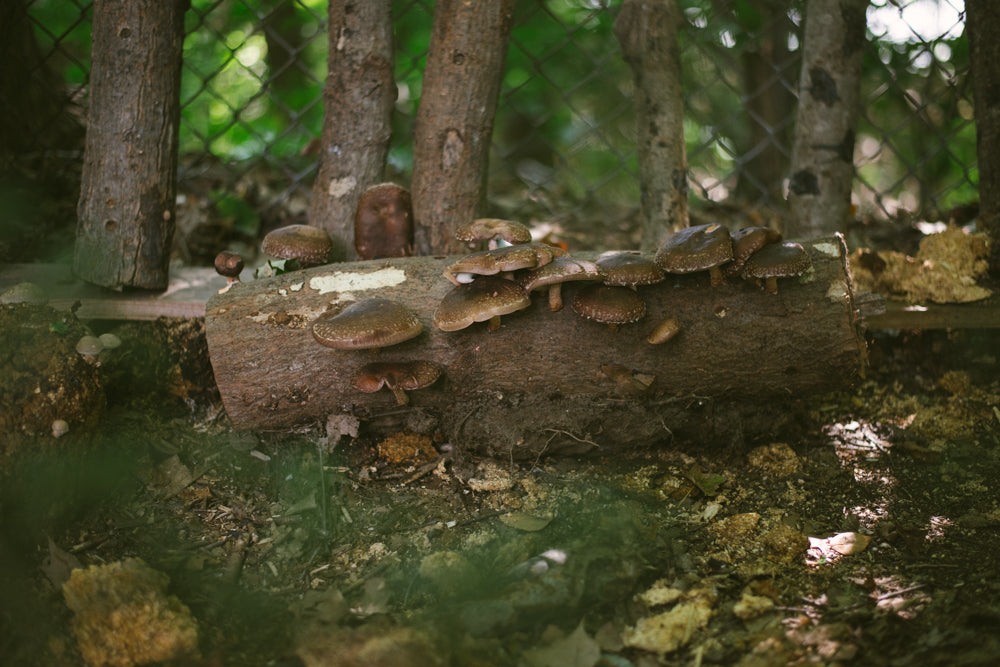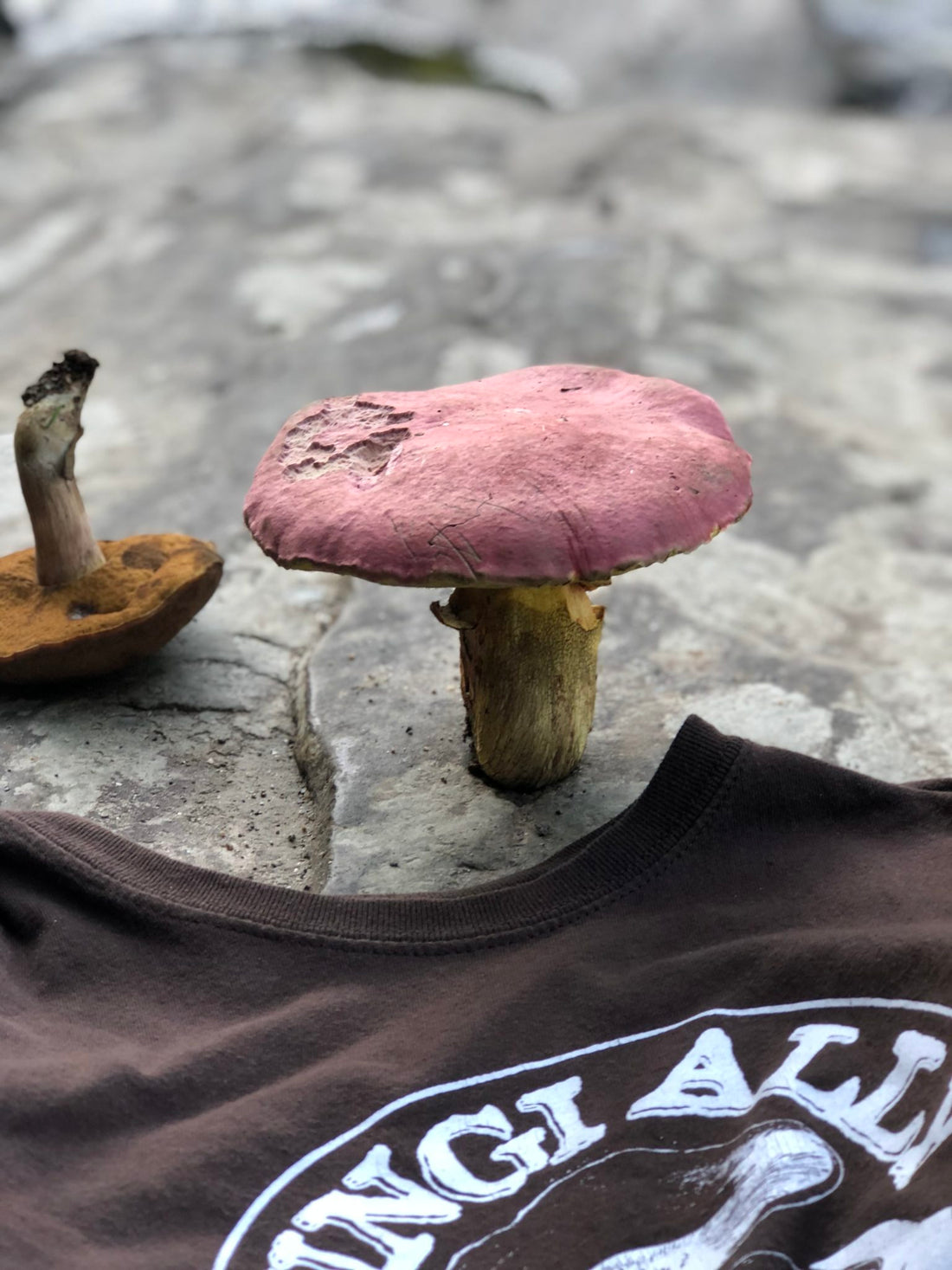Discover some interesting information on the kingdom fungi so you can better understand the role that fungus and mushrooms play in the ecosystem
All mushrooms are located in the kingdom fungi. There are three factors that characterize a fungus:
- One, the cell walls are made of chitin.
- Two, the mode of digestion is absorption.
- And three, they are heterotrophic.
Let’s pull these apart one by one to understand the kingdom fungi better.
Chitin is a complex, rigid molecule which also comprises lobster and insect shells. Most human stomachs cannot digest chitin. Since chitin is primarily indigestible when mushrooms are consumed raw, a majority of
the nutritional benefits are locked away behind this chitin and unavailable. This is not to say one can eat poisonous mushrooms raw safely! Some compounds in the mushroom are available to our human system without breaking the chitin down but most require the degradation of the chitin before consumption. Chitin can be broken down simply by heat in the process of cooking or making tea or by alcohol in the case of making tinctures.
The second determining factor of a fungus is their mode of digestion. Fungi are unique from most animals because they do not have stomachs. Fungi secrete enzymes outside of their body, breaking down whatever they are growing in and absorbing the nutrients back into their body. The enzymes that are secreted by fungi are strong compounds that not only break down the food source but also protect the fungus. These enzymes are a cocktail of different antifungals, antibacterials, and probiotics which guide the microbial growth around the mycelial network.
Some mushroom species, such as wine cap, require the presence of certain bacteria in order to fruit. The enzymes that are produced can be signals or food sources for certain bacteria to proliferate. One radically different consequence of this method of nutrition is that fungi need to grow on or in their food source. Fungi cannot survive in the mycelial state separate from their food source.

Lastly, fungi are heterotrophic, meaning they rely on an external food source. Fungi are not capable of photosynthesizing. Unlike plants they cannot transform the sun’s energy into matter. Fungi are the recyclers, the magicians throughout the cycle of life, that transform death into the possibility of life. Decomposition is not the only ecological role fungi play though. Let's go through three of the most common ecological roles fungi play.
Kingdom Fungi and Ecological Roles
Typically there are three ecological roles that fungi may play in an ecosystem: parasitic, mycorrhizal and saprophytic.
Saprophytes are organisms that consume dead material. These fungi are what eat wood, leaves, manure, corpses. These are the fungi that link death to life, that continue the cycle of nutrient flow on earth. Saprophytes are the typical mushroom cultivated by people. It is much easier to provide a mushroom with dead material and ideal conditions for growth and fruiting than doing the same on a living host. Things like logs and sawdust and wheat bran are very easy to store, handle, and manipulate to create favorable conditions for mushroom growth. Cordyceps militaris is a fungus that can be both parasitic and saprophytic making it possible to grow mushroom fruiting bodies even though a living host is not present.
 Mycorrhizal fungi are a type of fungus that creates a symbiotic relationship with plant roots, “myco” meaning fungi and “rhizal” meaning roots.
Mycorrhizal fungi are a type of fungus that creates a symbiotic relationship with plant roots, “myco” meaning fungi and “rhizal” meaning roots. Simply a fungus associated with roots! These fungi are on over 90% of plant species. Most of the trees we look at in our daily lives have fungi attached to their root system. These fungi play multiple roles in assisting plant health, nutrient access, and communication across individuals. Amazing studies have been done to illustrate how connected ecosystems really are. These mycorrhizal networks literally connect individuals of the same and different species to each other. Mycorrhizae allow the exchange of nutrients, flowing from sick and healthy trees as well as old and young trees. Through these mycorrhizal networks, information is passed regarding different stressors like pests that may be invading an ecosystem. On an individual level mycorrhizal fungi also expand the root system of plants and help access nutrients that are locked in the soil like phosphorus and pockets of water. Mycorrhizal filaments are much smaller than roots so can penetrate tiny rocks and cracks that are otherwise inaccessible by the plant. In exchange for these nutrients and water plants trade sugars developed during photosynthesis.
Parasitic fungi are fungi that attack a living organism. These fungi give the entire fungal kingdom a bad rap because of their perceived negative impact on human systems. Fungal parasites have a huge impact on crop loss in our agricultural systems. The continued use of monocultures and farming techniques that grow weak plants creates breeding grounds for fungal diseases. These diseases spread rapidly during wet periods and easily trave

l up the entire country over the course of a growing season. Many of these fungi do not create a mushroom but exist simply in the mycelial and spore stages of the fungal life cycle. Many of these fungi have asexual reproduction cycles where they can rapidly create genetically identical spores for further dissemination.

There are some mushroom-forming parasites as well. Honey mushroom, an edible which grows abundantly throughout the U.S., chaga, and cordyceps are all examples of this. One network of honey mushrooms, covering a stretch of forest in Oregon that expands 2000 acres in a continuous mycelial mat has been described as the largest organism in the world. Human perception is typically that parasites are a bad thing, but when the largest organism in the world is a parasite, it gives us something to consider, it must be doing something right.
Chaga is currently an extremely popular parasitic mushroom which grows on birch trees. Chaga is thought to have a variety of compounds that positively impact the human immune system. Cordyceps is a parasite not of plants or trees but of insects. Cordyceps attack a living insect larvae or pupae, consume it, and then fruit from the dead body of the insect. Some species of Cordyceps can cross over to being saprophytic allowing humans to produce fruiting bodies without the presence of insects. (
Want to interact with the kingdom fungi by growing your own mushrooms? Check out
our online courses and
mushroom spawn.
 Lastly, fungi are heterotrophic, meaning they rely on an external food source. Fungi are not capable of photosynthesizing. Unlike plants they cannot transform the sun’s energy into matter. Fungi are the recyclers, the magicians throughout the cycle of life, that transform death into the possibility of life. Decomposition is not the only ecological role fungi play though. Let's go through three of the most common ecological roles fungi play.
Lastly, fungi are heterotrophic, meaning they rely on an external food source. Fungi are not capable of photosynthesizing. Unlike plants they cannot transform the sun’s energy into matter. Fungi are the recyclers, the magicians throughout the cycle of life, that transform death into the possibility of life. Decomposition is not the only ecological role fungi play though. Let's go through three of the most common ecological roles fungi play.
 Mycorrhizal fungi are a type of fungus that creates a symbiotic relationship with plant roots, “myco” meaning fungi and “rhizal” meaning roots. Simply a fungus associated with roots! These fungi are on over 90% of plant species. Most of the trees we look at in our daily lives have fungi attached to their root system. These fungi play multiple roles in assisting plant health, nutrient access, and communication across individuals. Amazing studies have been done to illustrate how connected ecosystems really are. These mycorrhizal networks literally connect individuals of the same and different species to each other. Mycorrhizae allow the exchange of nutrients, flowing from sick and healthy trees as well as old and young trees. Through these mycorrhizal networks, information is passed regarding different stressors like pests that may be invading an ecosystem. On an individual level mycorrhizal fungi also expand the root system of plants and help access nutrients that are locked in the soil like phosphorus and pockets of water. Mycorrhizal filaments are much smaller than roots so can penetrate tiny rocks and cracks that are otherwise inaccessible by the plant. In exchange for these nutrients and water plants trade sugars developed during photosynthesis.
Parasitic fungi are fungi that attack a living organism. These fungi give the entire fungal kingdom a bad rap because of their perceived negative impact on human systems. Fungal parasites have a huge impact on crop loss in our agricultural systems. The continued use of monocultures and farming techniques that grow weak plants creates breeding grounds for fungal diseases. These diseases spread rapidly during wet periods and easily trave
Mycorrhizal fungi are a type of fungus that creates a symbiotic relationship with plant roots, “myco” meaning fungi and “rhizal” meaning roots. Simply a fungus associated with roots! These fungi are on over 90% of plant species. Most of the trees we look at in our daily lives have fungi attached to their root system. These fungi play multiple roles in assisting plant health, nutrient access, and communication across individuals. Amazing studies have been done to illustrate how connected ecosystems really are. These mycorrhizal networks literally connect individuals of the same and different species to each other. Mycorrhizae allow the exchange of nutrients, flowing from sick and healthy trees as well as old and young trees. Through these mycorrhizal networks, information is passed regarding different stressors like pests that may be invading an ecosystem. On an individual level mycorrhizal fungi also expand the root system of plants and help access nutrients that are locked in the soil like phosphorus and pockets of water. Mycorrhizal filaments are much smaller than roots so can penetrate tiny rocks and cracks that are otherwise inaccessible by the plant. In exchange for these nutrients and water plants trade sugars developed during photosynthesis.
Parasitic fungi are fungi that attack a living organism. These fungi give the entire fungal kingdom a bad rap because of their perceived negative impact on human systems. Fungal parasites have a huge impact on crop loss in our agricultural systems. The continued use of monocultures and farming techniques that grow weak plants creates breeding grounds for fungal diseases. These diseases spread rapidly during wet periods and easily trave l up the entire country over the course of a growing season. Many of these fungi do not create a mushroom but exist simply in the mycelial and spore stages of the fungal life cycle. Many of these fungi have asexual reproduction cycles where they can rapidly create genetically identical spores for further dissemination.
l up the entire country over the course of a growing season. Many of these fungi do not create a mushroom but exist simply in the mycelial and spore stages of the fungal life cycle. Many of these fungi have asexual reproduction cycles where they can rapidly create genetically identical spores for further dissemination.
 There are some mushroom-forming parasites as well. Honey mushroom, an edible which grows abundantly throughout the U.S., chaga, and cordyceps are all examples of this. One network of honey mushrooms, covering a stretch of forest in Oregon that expands 2000 acres in a continuous mycelial mat has been described as the largest organism in the world. Human perception is typically that parasites are a bad thing, but when the largest organism in the world is a parasite, it gives us something to consider, it must be doing something right.
Chaga is currently an extremely popular parasitic mushroom which grows on birch trees. Chaga is thought to have a variety of compounds that positively impact the human immune system. Cordyceps is a parasite not of plants or trees but of insects. Cordyceps attack a living insect larvae or pupae, consume it, and then fruit from the dead body of the insect. Some species of Cordyceps can cross over to being saprophytic allowing humans to produce fruiting bodies without the presence of insects. (
Want to interact with the kingdom fungi by growing your own mushrooms? Check out our online courses and mushroom spawn.
There are some mushroom-forming parasites as well. Honey mushroom, an edible which grows abundantly throughout the U.S., chaga, and cordyceps are all examples of this. One network of honey mushrooms, covering a stretch of forest in Oregon that expands 2000 acres in a continuous mycelial mat has been described as the largest organism in the world. Human perception is typically that parasites are a bad thing, but when the largest organism in the world is a parasite, it gives us something to consider, it must be doing something right.
Chaga is currently an extremely popular parasitic mushroom which grows on birch trees. Chaga is thought to have a variety of compounds that positively impact the human immune system. Cordyceps is a parasite not of plants or trees but of insects. Cordyceps attack a living insect larvae or pupae, consume it, and then fruit from the dead body of the insect. Some species of Cordyceps can cross over to being saprophytic allowing humans to produce fruiting bodies without the presence of insects. (
Want to interact with the kingdom fungi by growing your own mushrooms? Check out our online courses and mushroom spawn.

